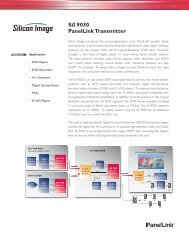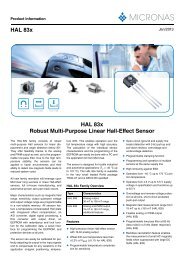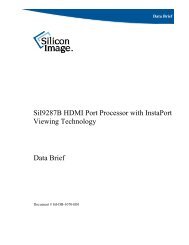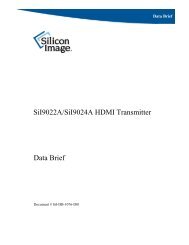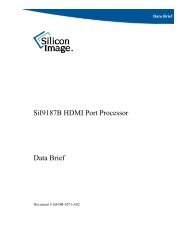Create successful ePaper yourself
Turn your PDF publications into a flip-book with our unique Google optimized e-Paper software.
ADVANCE INFORMATION<br />
<strong>UAC</strong> <strong>357xB</strong><br />
The next part of the configuration descriptor defines<br />
the audio format for playback and record. This is not<br />
programmable.<br />
GPIO[4...7] are used as media control keys:<br />
Table 4–6: Media control keys<br />
Table 4–4: Supported audio formats<br />
Pin<br />
Function<br />
Playback<br />
Record<br />
GPIO4<br />
Next Track<br />
16-bit Mono<br />
8-bit Mono<br />
GPIO5<br />
Previous Track<br />
16-bit Stereo<br />
16-bit Mono<br />
GPIO6<br />
Stop<br />
24-bit Stereo<br />
16-bit Stereo<br />
GPIO7<br />
Play/Pause<br />
The <strong>UAC</strong> <strong>357xB</strong> accepts all sample rates from 6.4 kHz<br />
to 48 kHz independently for playback and record.<br />
The final portion of the configuration descriptor defines<br />
the HID functions:<br />
The codec firmware uses the GPIO pins to connect<br />
keys which are related to the USB HID class. The<br />
standard configuration defines the GPIO0 to GPIO3 as<br />
input pins for the audio control shown in Table 4–5.<br />
With the use of this pins, the Windows Media Player<br />
can be controlled directly.<br />
The keys are polled every 1 ms by the microcontroller<br />
and the corresponding key codes are transmitted to<br />
the host on request when a key enters “high” state.<br />
The hosts polling rate is 8 ms. This parameter, however,<br />
is part of the configuration set, which can be<br />
downloaded from an external I 2 C EEPROM.<br />
Table 4–5: Standard key configuration<br />
Pin<br />
GPIO0<br />
GPIO1<br />
GPIO2<br />
GPIO3<br />
Codec Firmware<br />
Function<br />
Volume Up<br />
Volume Down<br />
Mute on-off toggle<br />
BassBoost on-off toggle<br />
GPIO[4..11] pins are not assigned to HID functions and<br />
can be used by a vendor specific driver or plug-in.<br />
Each pin can be configured as input or output pin with<br />
programmable pull down resistor and weak or strong<br />
driver strength.<br />
Headset Firmware<br />
In addition to the basic audio control there is a local<br />
mic-mute, controlled by GPIO[4]. A button connected<br />
to VDD allows to toggle between mic mute and<br />
unmute. For indication of the mute status an LED can<br />
be connected to GPIO[11]. This LED will stay solid if<br />
mic is NOT muted and will blink in 500ms rate if the<br />
mic is muted. Sidetone level is also muted with this<br />
function. However, the mute state is NOT reported to<br />
WIN OS and therefore the mute indicator in the WIN<br />
mixer will not change by this local mic mute. The WIN<br />
mixer can overwrite the local sidetone mute, i.e.,<br />
switch sidetone on again, even if the recording path is<br />
still muted.<br />
GPIO[5...10] are not used in the headset.<br />
4.3.1. Audio Class Requests<br />
The codec firmware supports all audio class requests<br />
which are required by the audio flow shown in Fig. 4–2<br />
and Fig. 4–3. The MIN/MAX/RES setting follow the<br />
limits which are defined in the audio processing apart<br />
from the main volume setting (FU1). In this case the<br />
overall range from −114 dB to +6 dB is limited to<br />
−40 dB to +3 dB (plus mute position) in order to fit the<br />
audible range to the volume slider in the WIN mixer.<br />
Micronas Aug. 20, 2004; 6251-650-1AI 25


